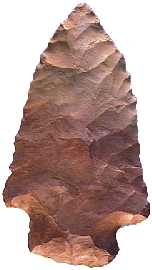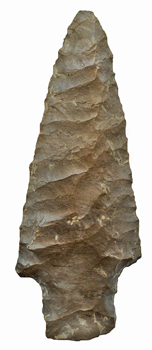





Point Type: ELK
RIVER
Also See: Beacon
Island, Benton, Big Slough, Buzzard Roost Creek
Location: Southeastern United States
Associated Dates: 8000 - 5000 B.P.
- Early Archaic
Morphology: Stemmed
General Description: The Elk River is a medium to large sized, long, narrow, stemmed Late Archaic dart point or knife form that features diagonal oblique transverse flaking scars on the blade (one or both faces) and is usually biconvex and is rarely plano convex in cross section . The stem is typically straight sided but is occasionally slightly expanding or contracting with typically a straight and rarely a slightly excurvate basal edge. The blade is long and narrow with unbeveled, recurvate edges. The proximal end has slightly expanding, horizontal or tapered barbs. The blade was finished by the application of oblique transverse flaking always on at least one face of the blade and usually on both faces. These flakes were removed at a steep angle and typically leave a median ridge. As a result of this flaking technique, marginal retouch is usually minimal. The stem was formed by the removal of one or two pairs of broad, steep, opposing percussion flakes from each side of the preform. The base is occasionally (25% of specimens) lightly ground.
The Elk River point type is a part of the Benton Cluster of points and is believe to be related to the Benton Stemmed type.
The Elk River is usually found in northern Alabama and southern Tennessee with occurrences in Kentucky fairly common. The point type is also found in very low frequency throughout the Ohio River Valley. Elk River points have been identified in Perry and Greene Counties, Indiana.
The typical
dimensions for the Elk River type are as follows - the length range is between
48 mm and 130 mm with the average being 72 mm. The width ranges from 22 mm to 38
mm with the average being 31 mm. The thickness ranges from 8 mm to 11 mm with
the average being 9 mm thick. The stem length ranges from 11 mm to 17 mm with
the average being 14 mm. The stem width ranges from 15 mm to 19 mm with the
average being 17 mm wide. The stem thickness ranges between 8 mm and 11 mm with
the average being 9 mm wide.
The Elk River type was named by James W.
Cambron in 1962 for examples which he recovered from the Elk
River site along the Elk River in Limestone County, Alabama.
About the Point Above (Left): The point pictured above on the left is a classic example of the Elk River type. The point is made from a patinated tan flint that is banded with a lighter colored dull chert (just above the barbs, and at the tip of the base and along the lower or left blade edge). The blade is knapped with diagonal oblique transverse scars which meet in a median ridge. The blade edges are still quite sharp to the touch especially back near the barbs. The point measures 83 mm in length and is 23 mm at the widest point which is at the barbs. The blade is 8 mm thick. The base has been slightly ground as have the sides of the stem. The stem is 13 mm long, 16 mm wide and 7 mm thick. This point was found in near the town of Lutts, in Wayne County, Tennessee. Catalog Number 29-25-D
About the Point Above (Center): The point pictured above in the center of the page is a highly reworked example of the Elk River type. The point is made from a patinated tan (distal end) to purple (basal end) dull chert. The blade is knapped with diagonal oblique transverse flaking. The point measures 70 mm in length and is 38 mm at the widest point which is at the barbs. The blade is 12 mm thick in the middle of the hafting area. The base has been slightly ground as have the sides of the stem. The stem is 12 mm long, 23 mm wide and 9 mm thick. In my opinion, this blade what is left of a well used, reworked knife which was probably much larger when new. The base and hafting area are very thick and the blade edges are much thinner. The thick hafting area illustrates perhaps how the hafting area was protected from rework while the blade was in use and lashed to a handle. This point was found in a creek near the town of Ramar, Tennessee. Catalog Number 79-27-D
About the Point Above (Right): The point pictured above on the right hand side of the page is a classic example of the Elk River type. The point is made from a patinated dark brown Buffalo River chert that has a few lighter colored tan flecks. The blade is knapped with diagonal oblique transverse scars which meet in a median ridge. The median ridge is biased towards the right side. The blade edges are still quite sharp to the touch especially back near the barbs. The point measures 77 mm in length and is 30 mm at the widest point which is at the barbs. The thickest part of the specimen is 9.25 mm thick at the barbs and the majority of the blade is 6.6 mm thick . The base has been slightly ground as have the sides of the stem. The stem is 16.8 mm long, 17.7 mm wide and 7.4 mm thick. This point was found in western, Tennessee and was formerly in the Will Burkett collection. Catalog Number 418-42-HH
References: Baker, Cambron & Hulse, Dragoo (c, e), Justice (1), Overstreet, Perino (2)
© Copyright 1997 - 2009 LITHICS-Net WWW.LITHICSNET.COM
Use your Browser's BACK Button to return to the LITHICS-Net Index.